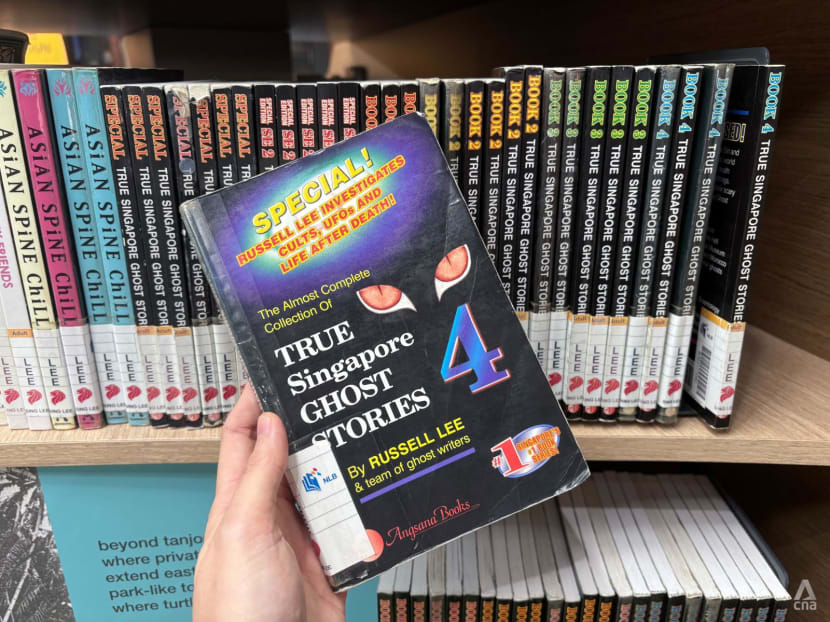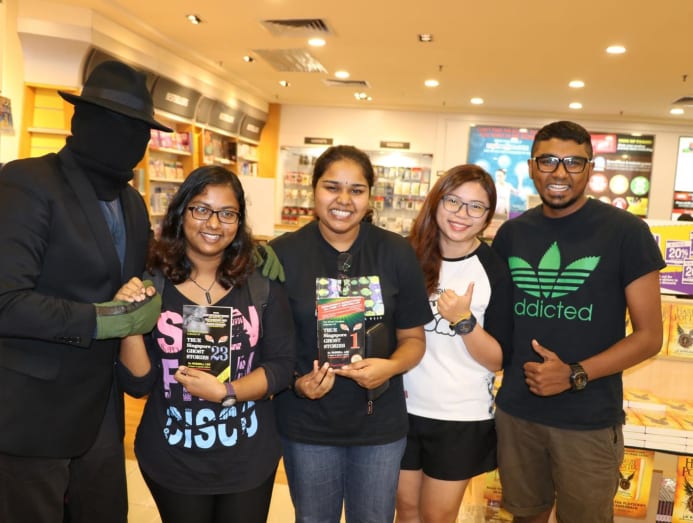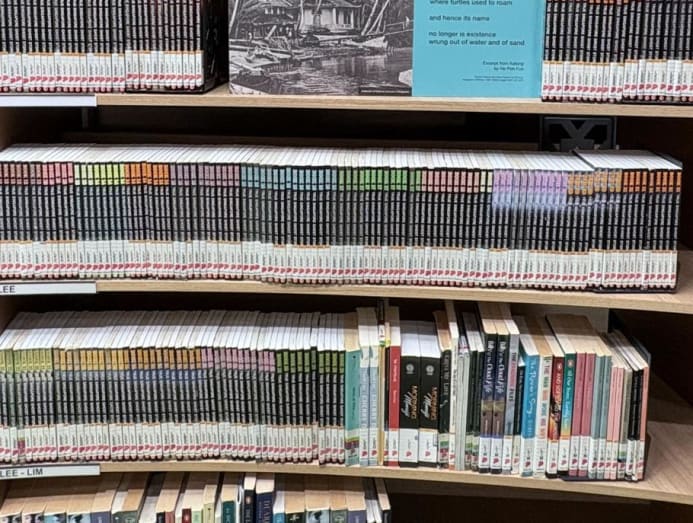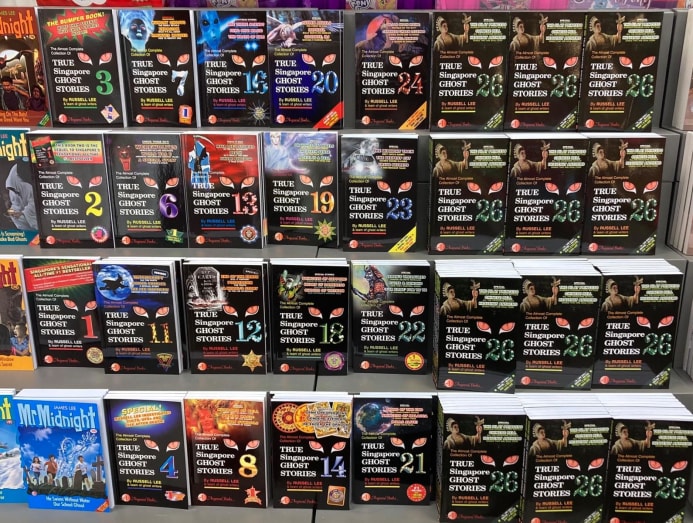Why is True Singapore Ghost Stories still so popular after more than 35 years?
Books from the series have ranked amongst the top 10 most borrowed physical adult books almost every year for the past 10 years, according to the National Library Board.

A fraction of books from The Almost Complete Collection Of True Singapore Ghost Stories at the Central Public Library. (Photo: CNA/Grace Yeoh)

This audio is generated by an AI tool.
It’s been over two decades since I read The Almost Complete Collection Of True Singapore Ghost Stories (TSGS), but I still remember being, well, haunted by its local lore for months after finishing a book.
These “true” story contributions, published under the pseudonym Russell Lee, ranged from tales about taxi drivers encountering long-haired female passengers along particular roads to the misadventures of teenagers at beachside chalets.
But the average reader knew it wasn’t what happened in the stories per se that struck terror in our bones. We had probably been exposed to more spine-chilling legends during school camps.
Rather, the most terrifying thing was knowing these stories allegedly happened to ordinary Singaporeans in ordinary places during an otherwise ordinary day – and therefore it could happen to any one of us.
This hyperlocal relatability is perhaps a reason TSGS gained a loyal fanbase, following its inception in 1989.
With fact-checking more crucial than ever with information today, however, the series has also since received its share of criticism on social media. Commenters on a Reddit thread from five years ago, for example, questioned the veracity of the stories. Some claimed they knew people whose “fake” story submissions were published.
Others may argue that publishing under a pen name could mean less accountability or credibility, especially since keeping Lee’s identity a secret is part of the allure.
Yet, readers don’t seem bothered. Book 27, the latest edition that was released in 2023, topped the National Library Board’s (NLB) list of most borrowed physical adult books last year, while Book 1 placed third, according to NLB’s 2024 Year-In-Review released in April.
Books from the series have ranked amongst the Top 10 most borrowed physical adult books “almost every year for the past 10 years”, said an NLB spokesperson.
To me, more fascinating than whether TSGS is legitimate or who’s the person (or people) behind the “Russell Lee” mask is what makes the series one of the most enduring pieces of Singapore literature.
“SIMPLE” LANGUAGE, WRITING STYLE

When I leafed through a TSGS book for the first time in over 20 years, it was obvious to me that a key reason for its popularity is its wholehearted embrace of what I call the template Singaporean writing voice.
The sentences are simple, short and direct, most sticking to a basic subject-verb-object structure. They also don’t vary much in length or complexity, which tends to flatten the natural rhythm of the prose.
Similarly, the language is utilitarian, with scant use of descriptive flourish. It leans towards observational rather than experiential writing too, minimising personal perspective or reflection.
While many, including myself, may find this produces writing that lacks oomph, I suspect that is precisely why others devour book after book.
In an email interview with CNA Lifestyle, Lee said Singapore has put its own spin on the English language and created one of its “most wonderful varieties”. Singlish is a “beloved aspect” of this Singapore version of English.
“It is this simple language that is employed by Russell Lee. It makes an immediate connection with Singaporeans,” he wrote over email, where he declined to reveal identifying personal details beyond the known fact that he’s Singaporean.

Besides, being anonymous has helped him to “better connect” with readers, he said. The “entire focus” of the TSGS series has been to “provide entertainment” from the start, and this focus remains unchanged.
TSGS was the brainchild of his publisher at Angsana Books, he recalled. Its popularity was followed by other notable local series, such as Mr Midnight by James Lee and Classic Singapore Horror Stories by Damien Sin.
Each TSGS book receives “hundreds of submissions”, Lee said, in addition to those from his team of writers and the interviews he conducts. He also seeks submissions from younger readers, whose views can be “incisive and thought-provoking”, to encourage them to read and write.
Once a story is in the bank, it’s then chosen for publication based on “entertainment levels”, he said. As the books are for a general audience, one of his challenges is getting the “fear factor” right, ensuring he doesn’t go over the top.
In this respect, it seems TSGS continues to be bang on the money. Findings from NLB’s 2021 National Reading Habits Study indicate that thrillers, folklore and horror are popular fiction genres enjoyed by adult readers.
These are elements featured in TSGS and “might have contributed to its enduring popularity” amongst adult readers, said the NLB spokesperson.
“Of course,” Lee added, “my interest in the supernatural and related topics gives the books focus and direction, and an underlying wholesome feel.”
CULTURALLY RELEVANT AND RELATABLE

TSGS’ readability is enhanced by its relevant and relatable cultural backdrop.
It’s an ingredient that, admittedly, hasn’t always led to successful storytelling in other books and movies. It can feel off-putting to see Singapore represented in ways that may be easily perceived as forced authenticity, after all.
But being, in my opinion, “too close to home” appears to have worked in TSGS’ favour. Many stories are situated in, say, the confines of Housing and Development Board (HDB) flats and local landmarks.
All this provides “very familiar context for the paranormal to happen”, Singaporean writer Gwee Li Sui said in an NLB video promoting his 2021 online lecture series, How To Fall In Love With Classics.
“We have all these urban myths floating around all the time in our lives. And it's really very much part of being a Singaporean that we consume this on a daily, almost weekly, basis … It fuels who we are, how we enjoy a sense of place in Singapore.”
Singapore’s multicultural landscape is also “grist for the mill”, said Lee. “It is a unique situation, unlike anywhere else in the world.”
TSGS deals with “very interesting intersections”, added Dr Gwee in the NLB video. For one, Singapore’s multiculturalism results in stories about the different ghosts we have in this part of the world, while our urban changes set the stage for various “possibilities of the supernatural here”.
True Singapore Ghost Stories has become a beloved feature of Singaporeana.
Still, Lee said setting a story in Singapore is but one aspect that has made TSGS so popular.
He admits there was “no way anyone could have known the series would be loved by Singaporeans and that it would go on for more than 35 years”. The books have a readership in Malaysia as well, and Singaporeans living and studying abroad continue to buy the books, he said.
For him, the most rewarding achievement has been to see Singaporeans reading TSGS for leisure. Many readers have also said the series led to their “improved grades in English”, and that it was an “affordable alternative” to private tuition.
So the longstanding series may have its detractors – albeit likely for the same reason its fans continue to uphold its cult following. Dr Gwee in the NLB video introducing his lecture series How To Fall In Love With Classics had acknowledged that certain people believe TSGS doesn’t deserve to be deemed classic.
But it’s clear that TSGS has become a “beloved feature of Singaporeana”, according to Lee. This typically means something has hyperlocal flavour, often appealing to shared memory or identity.
I can see why too, though I’m not its target demographic. Chiefly, TSGS doesn’t pretend to be what it’s not. Despite the country's myriad changes over several generations, the series remains unapologetically Singaporean at its core, down to its plain-spoken voice.

Perhaps its enduring popularity has also “something to do with who Russell Lee is”, Lee himself suggested.
Pointing to the “truly multicultural environment” where he grew up, he recalled fewer distractions in Singapore’s kampungs, which meant children loved to read. The introduction of National Service then became a “unifying experience among Singaporeans and … a rite of passage”, he added.
“Singapore was in a state of extreme flux. It was fertile ground for the imagination and the stories that were to follow,” he said.
“Shared stories have the ability to unite us. They create fond memories of Singapore. Memories which remain throughout our lives, and stay with us wherever we may travel to. The TSGS books have done this.
“This phenomenon is completely spontaneous and a grassroots miracle, a rarity in Singapore. In a sense, this series belongs to Singapore.”
So, the burning question: Will there be more? Book 28 “might well be my last”, Lee said – though he hopes not.
“You give a bit of your life for each story. I wish I had more time. The time is short and I work one book at a time. There will come a time, not long from now, when I have to finally stop, take off my mask and put down my pen.”






